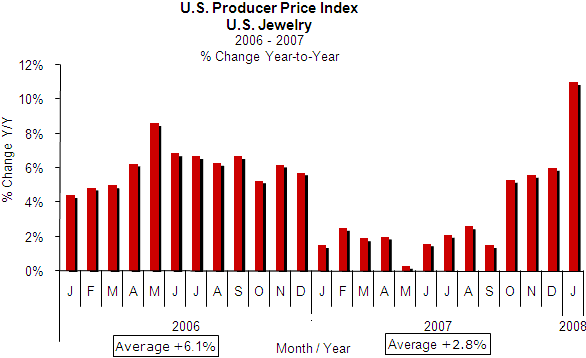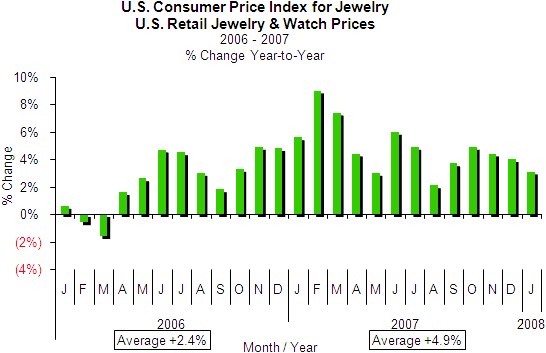IDEX Online Research: Jewelry Producer Prices Surge by 11% in January, a Near-Record
March 13, 08
Retailers should prepare for substantial price increases from their suppliers, based on a leap of 11 percent, year-over-year, in the January Jewelry Producer Price Index (JPPI) in the U.S. market.
Monthly records of the JPPI go back nearly thirty years; the last time there was a monthly increase of this magnitude was in June 1983 when the JPPI was up 11.8 percent, a period of huge volatility in jewelry producer prices. Since then, the largest price increases – mid-to-upper single digits – occurred in 2006.
Consumer prices of jewelry and watches rose by a much more modest 3.1 percent in January, according to the Bureau of Labor Statistics’ Jewelry Consumer Price Index (JCPI). Jewelry prices were up by 4.2 percent, while watch prices fell by 3.8 percent in the month. Watch sales represent about 12 percent or so of total U.S. jewelry industry sales.
Several publicly held retail jewelers have announced that they will raise retail jewelry prices to varying degrees this Spring. We believe that they will need to review their cost structure again, in light of the surge in prices during January from their suppliers.
Clearly, suppliers are now passing along their recent cost increases. The big question is this: will they stick, in light of the recessionary environment? Retail jewelry sales were “less bad” for most jewelers in January and early February versus the dismal 2007 holiday selling period. It is too early to forecast U.S. jewelry sales for the balance of 2008, though our preliminary forecast of +2-3 percent now seems too high, especially since the Fed has cut its economic growth outlook in the last couple of weeks.
The outlook for further price increases is clear: recession or not, neither suppliers nor retailers can afford to continue to live with declining margins. Consensus forecasts call for continued higher precious metals prices, while overall diamond prices remain stable, with a modest upward bias. Thus, cost pressures will remain at all levels throughout the jewelry pipeline for the foreseeable future.
January 2008 – Jewelry Price Inflation Rises
- Jewelry Producer Price Index (JPPI) +11 percent in January – U.S. jewelry producer prices leaped by 11 percent in January, 2008, according to the Bureau of Labor Statistics (BLS). It was inevitable that suppliers could no longer cope with steadily rising costs without passing the full brunt of those increases along to their customers. There were broad hints in the JPPI late in 2007 that this surge was materializing. After nine months of modest supplier price increases in 2007, the JPPI jumped substantially in October, November, and December. Arguably, the very modest +1.5 percent gain in the JPPI in January 2007 set the stage for a large increase this year by making the year-over-year comparison easy. But January’s JPPI surge is not a statistical aberration; it is real.
- Jewelry Consumer Price Index (JCPI) +3.1 percent in January – U.S. jewelry consumer prices rose by a modest 3.1 percent in January, as calculated by the BLS. This is the calm before the storm, in our opinion. Many jewelers are expected to follow the lead of Sterling and Zale, both of whom have announced that they will selectively raise their prices this Spring. If the January JPPI is any indication of trends that could materialize this year, retail jewelry prices are set to surge. This sets the stage for stagflation, a term economists use to describe a period when the economy isn’t growing, but prices are rising. Stagflation is usually followed by a period of rationalization; prices retreat, taking out the weak competitors who haven’t rationalized their cost structures.
Jewelry Producer Price Inflation Leaps in January
Jewelry producer prices surged to a near-record level of 11 percent in January 2008. This sharp jump in the jewelry producer inflation rate was due to two factors: 1) rising prices of most commodities used in jewelry manufacturing; and 2) a 12.7 percent increase in the price of gold and platinum jewelry, of a major component of the JPPI.
Unfortunately, comparisons were very easy against last year’s 1.5 percent gain in the JPPI for January 2007, one of the smallest gains during the year. It is clear that this year’s supplier price increases are very real, and driven by higher component costs, rather than a trick of math.
The following graph summarizes the monthly Jewelry Producer Price Index for inflation since the beginning of 2006. The percentage figures are based on year-to-year comparisons of the BLS Jewelry Producer Price Index.
 Source: BLS |
Jewelry Consumer Prices Quiet in January
It is the calm before the storm at the retail level for jewelry prices. During January 2008, retail prices of jewelry in the U.S. market rose by a modest 3.1 percent, well below last year’s average of 4.9 percent for the year. Most jewelers have been hesitant to raise prices in front of the Valentine’s selling period, especially since demand was so soft in the holiday period. Further, economists are calling for a recession in the first half of 2008, and no jeweler wants to raise prices and scare off customers. Unfortunately, there really isn’t much price elasticity in a recessionary environment. Shoppers are already in a mental recession, and no amount of price concessions – short of giving goods away – is going to create significant store traffic and demand. If anything, this is a good time to raise prices. When the economy recovers, retailers will have their new prices in place, and consumers won’t know the difference.
During January, retail jewelry prices were up 4.2 percent in the U.S. market while retail prices of watches dropped by 3.8 percent. Department of Commerce statistics confirm that watch sales are roughly 12 percent of total jewelry industry sales. Last year, preliminary figures indicate that U.S. jewelry and watch sales were about $64.8 billion.
The graph below summarizes the percentage change in retail prices of jewelry and watches by month on a year-to-year basis since 2006. The percentage change is based on a comparison to the same month a year ago.
 Source: BLS |
Outlook: Higher Prices on the Horizon
Previously, we had predicted that both jewelry consumer prices and jewelry producer prices would rise by about 7 percent in 2008. We’re going to stay with those forecasts, but they are a bit tentative, given the surge in the JPPI in January. For sure, prices are headed higher as suppliers and retailers attempt to recoup large cost increases which have hit the industry over the past three years or so.